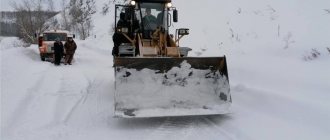When some kind of explosion occurs or for other reasons we hear about the destruction of a building, we feel uneasy. Most city residents live in high-rise buildings, and today you won’t surprise anyone with some new skyscraper. We also sometimes go to concerts and theaters; in water parks, gyms and hypermarkets. All these buildings are distinguished by their scale and large crowds of people. And we all understand that in the event of the collapse of such a structure, there will be no casualties.
What to do in case of a collapse? And if it is impossible to leave the premises, what should you do? How to help others? Is it possible to prevent destruction? We will give a qualified answer to all these questions. Let this information never be useful to you, but if it does come in handy, then our advice will definitely help you not to panic and act correctly, and perhaps even save your life.
Basic actions in case of building collapse and blockage
If you feel a vibration or hear an explosion, or see signs of destruction in buildings, then immediately leave the room, taking with you only the essentials (documents, water, flashlight, phone) and only if you have time for this (Figure 1).
In such a situation, you should act like this:
- You can only leave a dangerous building by using the stairs. Do not use the elevator under any circumstances, it is dangerous.
- Along the way, you will meet panicking people, and perhaps you yourself will experience attacks of fear. Pull yourself together, you will grieve later, there is no time now. Try to bring others to their senses too, using harsh and strict expressions. Everything must be done quickly.
- Under no circumstances should you jump from a floor higher than the first. Only movie stuntmen land beautifully.
- There may be a traffic jam of people leaving the building. It would be very unwise to push, express aggression and start conflicts. One fallen person will create a much larger traffic jam, and it will definitely not be possible to get out faster. Therefore, if you have Napoleonic blood flowing in you and you feel the strength to organize a crowd, this will lead to a quick evacuation and save many lives.
Figure 1. If a building collapses, do everything possible to save a life.
Once you are outside, get as far away from the collapsing building as possible.
What to do in case of a collapse
If you feel the vibration of the walls and signs of imminent collapse, you should immediately leave the building. Take documents, a flashlight and spare batteries with you (you should have all this in one place; you may not have time to look for it).
On this topic ▼
Emergency and search and rescue work in rubble conditions
When leaving the premises, use only the stairs. Try to sharply and firmly suppress panic behavior in other people. You cannot jump from windows or balconies that are located above the 1st floor. When you go outside, try to move as far as possible from the building being destroyed.
If you cannot leave the premises, you should open the door and find a safe place. These include: corners between walls, doorways in load-bearing walls, frame beams. You can also use a cast iron bathtub as a refuge.
If you don't have time at all, then use the table. It can protect you from debris and dust. If a building collapses, cover your ears to prevent damage to your eardrums. The most optimal position is that of the embryo.
If possible, stay away from windows, electrical appliances, and gas equipment. If you have a telephone, use it only to call emergency services.
How to act for a person in ruins
Actions of a person under the rubble
- First you need to calm down and even out your breathing. Remember that there is a limited amount of oxygen under the rubble.
- Focus on your own sensations: do you feel pain, can you move your legs or arms, can you change location, are you hurt and how badly.
- In addition, you should look around and listen. Perhaps there will be another person next to you, and you can support each other.
- Do not make sudden movements, save your strength and energy. Remember that a person can live long enough without food and water if energy consumption is reduced.
- Give sound or light signals. You can find a small object that you can use to tap on the wall.
We also recommend that you read the following literature:
Textbook: Rules for carrying out emergency rescue work during the collapse of buildings and structures. FGU VNII GOChS, Moscow, 2004
Causes of collapse of structures
The reasons can be very different. For example, destruction may occur due to poor quality materials used in construction, or the project itself was made with errors. Builders and installers could also do their work dishonestly (Figure 2).
It also happens that the destruction of a building occurs not because of a person, but because of surprises from nature. For example, landslides, earthquakes, and hurricanes can significantly damage what has been built by man.
In addition, it could be that certain structural loads were not taken into account during construction. This could happen either due to the negligence of people who did not take into account local natural phenomena, or natural phenomena acquired new characteristics over the years. This has happened quite often over the past decades. Either hail in May, or grass in December. Therefore, it is quite possible that at the time of designing this house there were no earthquakes in that area, but 10 years later everything changed, not for the better.
Another common cause of major destruction is the use of buildings whose service life has long expired. In this case, the characteristics of building materials and structures in general are significantly reduced. Or there may be a different situation. Someone somewhere saved money and built it without taking into account certain loads, such as vibrations or oxidizers, temperature differences. As a result, the building will not last long.
Figure 2. Quite often, collapses are provoked by people themselves
Sometimes explosions are deliberately organized by terrorists, or children left unattended by their elders may be “playing around.” Well, the most common reason is a violation of the rules for operating various communications and the structure itself. Most often we hear about explosions due to gas leaks, which leads to severe destruction.
Characteristics of collapses and their main causes
Most often, the collapse of a building in peacetime can be caused by:
- mistakes that were made during the design of the building
- poor quality of materials used
- the occurrence of corrosion and aging of building structures, leading to a decrease in their performance characteristics
- Unscrupulous execution of installation and construction
- natural phenomena such as rainstorms, hurricanes, earthquakes, landslides
- additional, not provided for by the design, loads on structures, as well as the impact on them of oxidizing agents, low or high temperatures, vibration, and vapors.
- Violation of established operating rules for various structures can lead to spontaneous combustion, explosions, and fires (for example, a domestic gas leak).
What to do in case of a collapse
An emergency situation cannot be predicted and, of course, it is impossible to protect yourself 100%. The most important thing in such a situation is not to panic. In fact, it’s easy to write about this now, but to control yourself, to remain calm when a building shakes or you hear an explosion, is not so easy. Especially when other members of your family are also in danger (Figure 3).
Figure 3. Algorithm of actions in case of collapse
To calm down, psychologists advise to distract yourself and think about something good. You can try listing something, for example, cities, names of something, or colors. You really need a cool mind to coordinate your actions as correctly as possible.
If it is impossible to leave the building
If you see that it is no longer possible to leave the building, then you need to take several steps, thanks to which you can then get out from under the rubble and save your life.
How to behave if you find yourself under a rubble
Comments are off
The causes of building collapses can be domestic accidents, design errors, poor condition of the building, or terrorist attacks.
Therefore, everyone needs to know what to do if a building threatens to collapse and how to behave if you find yourself under its rubble.
What to do if there is a threat of building collapse
If there is a threat of building collapse, it is strictly forbidden to use the elevator - try going down the stairs or through emergency exits.
If there is no opportunity to leave the building at all, then hurry to find a safe position (doorways or wall corners under the frame beams). Stay away from windows, gas cylinders, columns, and fragile metal structures.
What to do if you find yourself under the rubble of a building
If a collapse occurs and you find yourself under rubble, do not make sudden movements. If an arm or leg is caught in debris, do not try to pull the limb out as this may cause further collapse.
Try not to lose heart, calm down. Breathe deeply and evenly. Prepare yourself for the fact that you will be saved.
If you have a mobile phone, call the rescuers at 112.
When using a flashlight or a mobile phone with a built-in flashlight, the device should be turned on and off periodically (this will save energy).
If you are deep under the rubble of a building, move any metal object (ring, keys, etc.) left and right so that you can be detected using an echo direction finder.
Use your voice and knock to attract people's attention. During rescue operations, a “time of silence” is announced every hour. These minutes are intended to hear the voices of people under the rubble.
If the space around you is relatively free, do not light lighters. Save oxygen. In addition, a spark can cause an explosion if fuel spills or gas spreads.
If you have the opportunity, use improvised objects (boards, bricks, etc.) to strengthen the ceiling from collapse.
If you are very thirsty, put a small pebble in your mouth and suck on it, breathing through your nose.
You can only get out if there is a hole formed by long and strong structures. Move carefully, trying not to cause a new collapse, be guided by the movement of air coming from outside.
Remember, by maintaining your composure, you maintain the physical strength needed to wait for the search service.
When rescuers find you, if possible, tell them your name and tell them about your injuries, what you see around you, and what part of the building you were in during the collapse.
Press service of the Main Directorate of the Ministry of Emergency Situations of Russia for the Republic of Mari El.
Source: www.12.mchs.gov.ru
27.04.2014 9:08
Methods and technologies for equipping passages and passages in rubble
Depending on the scale and structure of the rubble, passages (passages) in them are equipped by clearing the debris to a hard or soil base or by equipping a passage on top of the rubble.
A passage by clearing to a hard or soil base is equipped if the height of a continuous blockage does not exceed 0.5 meters, and the local blockage has a length of no more than 8 ÷ 10 meters and a height of up to 1 meter.
The width of the passage is set depending on the planned traffic intensity: for one-way traffic, at least 3 meters, for two-way traffic - 6.5 meters.
To create passages (passages) in the rubble, the mechanized group is reinforced by a complex of track-laying machines: one - two (bulldozers) of traction class 25 TC (or IMR-2M, SPM) and two - three bulldozers of traction class 6 ÷ 10 TC.
To cut the reinforcement connecting the elements of reinforced concrete structures, as well as metal elements protruding from the walls of the passage, a team (team) of cutters consisting of 3 - 4 people with cutting machines such as “HUSKVARNA K750”, “SHTIL”, “MAKITA”, as well as with a set of hydraulic rescue tools driven by a pumping station (“LUKAS”, “PROSTOR”).
When conducting reconnaissance at the work site, the head of the mechanized group must determine the size and structure of the blockage, clarify and indicate the direction of the passage (travel), determine safety measures when carrying out work taking into account the situation, brief and assign tasks to the personnel of the mechanized group, determine the technology of the device passage (passage), organize the placement of equipment and work, supervise their implementation.
The technology for making a passage (passage) in a local rubble includes the following technological operations:
- layer-by-layer cutting of the blockage with several passes of the bulldozer along the entire length of the blockage;
- expansion of the passage (passage) to the required size;
- cleaning the walls of the passage (driveway) from protruding metal objects and sharp debris.
The technology for making a passage (passage) in a solid rubble includes the following operations:
- gradual clearing of the passage (driveway) from large debris by moving them away from the passageway (driveway) route with a bulldozer of traction class 25 TC (or IMR-2M, SPM);
- widening the passage (passage) to the required dimensions and clearing the walls with bulldozers of traction class 6 ÷ 10 vehicles;
- arrangement of sidings for one-way passage (passage);
- clearing the passage (driveway) from small debris, trimming protruding metal objects, fittings, etc.
The driveway on top of the rubble is equipped with long-distance rubble, with a height of continuous obstruction of more than 0.5 meters and a height of local obstruction of more than 1 meter.
Depending on the structure of the rubble, the presence of local construction materials near it and the time to complete the task, the passage can be equipped in the following ways:
- leveling and compaction of debris and small fractions along the travel route;
- leveling and compacting the rubble, sealing irregularities and cracks between structures with crushed stone and sand;
- leveling the roadway and securing it with reinforcing polymers or quick-hardening solutions.
To carry out the task, a unit is assigned consisting of one bulldozer with a traction class of 25 TC (or IMR-2M, SPM), three bulldozers with a traction class of 6 ÷ 10 TC, 3 – 4 specialists for cutting reinforced concrete and metal structures.
The technology for equipping passage over a rubble includes the following technological operations:
- marking the direction of travel;
- equipment for entering the rubble;
- clearing the driveway from large debris and compacting the driveway with a bulldozer of traction class 25 TC;
- widening the passage to the required size, clearing and sealing the passage;
- arrangement of sidings and exit from the rubble using bulldozers of traction class 6–10 vehicles;
- trimming protruding metal and reinforced concrete structures.
If it is necessary to further improve the quality of the roadway, it can be sprinkled with a layer of sand or watered with fastening solutions (quick-hardening polymer solution or foaming polymer materials).
Excavation of pits and recesses in the rubble for the purpose of access to walls, ceilings, window and door openings of blocked premises is carried out mechanically or manually.
It is advisable to use the mechanized method when the depth of the dam is over 2 meters and the presence of large, heavy debris in its structure.
To carry out the task, a mechanized group and emergency rescue units with means of mechanization of work, reinforced with engineering and construction equipment of construction organizations of the urban district, are assigned:
Example: a truck crane with a lifting capacity of over 16 tons, an excavator with a backhoe with a capacity of at least 1 m3, a gas cutting kit, cutting machines such as “HUSKVARNA K750”, “SHTIL”, “MAKITA” with a diamond blade, a stationary electric generator with a capacity of 20 kW (for example from RV -2 (Iveco-Magirus) or AG-NATISK).
Excavation of a pit (excavation) in the rubble is carried out manually when the depth of the rubble is no more than 2 meters and its composition is made of small fragments, as well as when making excavations in the rubble inside buildings in order to access the floors of blocked premises.
To complete the task, a unit (5-6 people) is assigned with small-scale mechanization equipment: sets of hydraulic rescue tools driven by a pumping station (“LUKAS”, “PROSTOR”), cutting machines such as “HUSKVARNA K750”, “SHTIL”, “ MAKITA", a manual winch with a lifting capacity of 0.5 tons and manual non-mechanized firefighting tools (crowbars, shovels, sledgehammers, etc.).
Dead-end passages in the rubble are equipped to provide access for rescuers, personnel of engineering and technical units, as well as emergency technical services personnel to blocked premises and utility equipment.
Depending on the dimensions and structure of the blockage, passages are equipped with clearing of the blockage to a hard or soil base or on top of the blockage.
passages by clearing structures to the base when the height of the blockage is up to 2 meters and the length is up to 20 meters, if it is not possible to make an opening in the ceiling of the blocked room.
If the length of the dam is over 20 meters and the height is over 2 meters, the passage to the wall or ceiling of the blocked room should be equipped on top of the dam .
The minimum width of the passage at the bottom (when only rescuers with small-scale mechanization equipment move through it) should be 100 ÷ 120 cm. If it is necessary to move other mechanization equipment along the passage, the width of the passage is set taking into account their dimensions.
To make a passage, taking into account the dimensions and structure of the rubble, an engineering and technical unit is assigned with means of mechanization of work, a crane-manipulator, a jib crane with a boom reach of at least 8 meters, an excavator or a front-end loader with a bucket capacity of at least 1.0 m3, a bulldozer with a traction class of 6 ÷ 10 vehicles, cutting machines such as “HUSKVARNA K750”, “SHTIL”, “MAKITA”, sets of hydraulic rescue tools driven by a pumping station (“LUKAS”, “PROSTOR”), a stationary electric generator with a capacity of 20 kW (from RV-2 (Iveco-Magirus) or AG-NATISK). In addition, 2 ÷ 3 slingers are appointed.
The technology for constructing a passage with clearing the blockage to the base includes the following basic operations:
- tracing the passage through the rubble;
- preparation of the site at the beginning of the blockage for the installation of an AT with a CMU (truck crane);
- cutting large-sized debris and pinched structures along the route of passage to dismantling blocks (taking into account the lifting capacity of the crane, truck crane), using cutting machines, GASI kits;
- alternately removing the cut dismantling blocks with a crane and clearing the passage of small debris with a front-end loader or excavator;
- cleaning the side walls of the passage from sharp debris and protruding parts of metal structures and fittings.
The debris removed from the passage is placed on the sides of the passage at a distance that prevents them from collapsing into the passage.
Fire extinguishing on the routes for units entering areas (objects) of emergency rescue operations and during their conduct, as well as localization of smoke in areas (objects) of work are organized and carried out in accordance with the requirements of regulatory legal acts and organizational and methodological instructions (recommendations) of the Ministry of Emergency Situations Russia.










